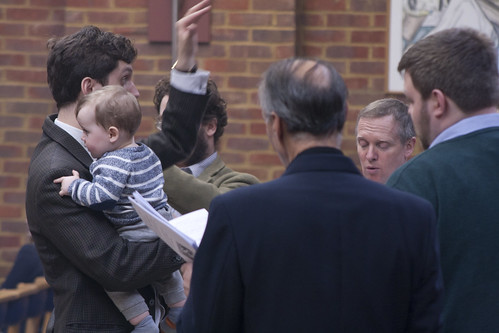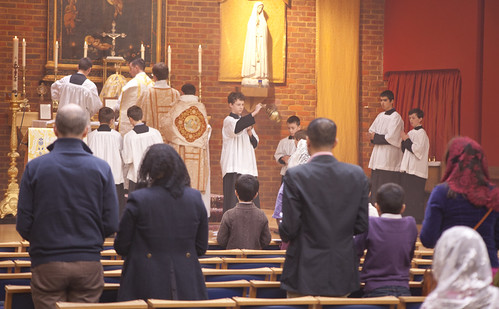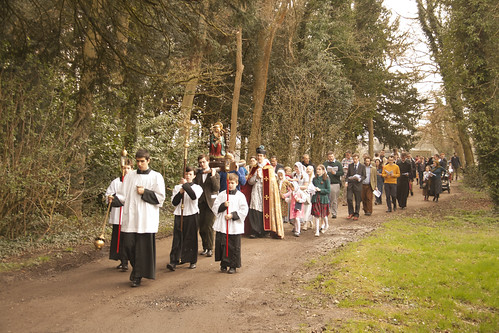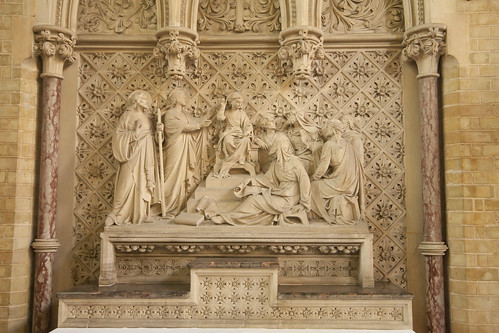Chairman's Blog
New book by Martin Mosebach
 Angelico Press has brought out a new book, a collection of essays, by Martin Mosebach, author of the excellent book The Heresy of Formlessness.
Angelico Press has brought out a new book, a collection of essays, by Martin Mosebach, author of the excellent book The Heresy of Formlessness.
Amazon.co.uk has it here.
I was asked to write a blurb for it, here it is in full.
Martin Mosebach has once more demonstrated his ability to provide provocative insights into the condition of modern Catholicism in this collection of essays. He notes the tension between the liturgical principle, found in East and West, that the rites be "fear-inspiring", and the modern worshipper who "relaxes in an armchair waiting for [God] to arrive". He suggests that the needs of the ordinary believer are satisfied, if at all, in the kitsch products of Lourdes gift-shops, while elite Catholicism offers him an empty aesthetic puritanism. He suggests that the replacement of the monarch with the people, as the holder of sovereignty, makes for fiscal profligacy. He explores the parallel between the prayer wheels of oriental religions with the church bells of European Christianity. These essays are a tonic to our deep-rutted discourse on liturgy, spirituality, and religious sociology, refreshing, challenging, and setting us on new paths of thought.
Should the Pope apologise to Mexico?
A recent article of mine on LifeSite. It begins:
Priest attacked for wearing a clerical collar
A recent LifeSite article by me. It begins:
Cardinal Marx on Celibacy
A recent LifeSite article of mine. It begins:
Re re-print: the Parish Ritual
Cross-posted from Rorate Caeli.
Preserving Christian Publications has brought out a beautiful reprint of a book once almost as essential to the work of a priest as the Missal or Breviary: the Parish Ritual.
Published in the USA in 1962, it is the equivalent to the Small Ritual published in England in 1964. It is an extract from the Missal and the Roman Ritual, containing the texts needed by a priest for weddings, baptisms, and funerals, Extreme Unction, receptions of converts, and a large number of blessings (of Rosaries, the Miraculous Medal, Holy Water, etc. etc.), all in a handy format worthy of use in the liturgy itself.
One of the useful features of the book is that although all the Latin texts have a translation on the same page, a clear distinction is made between what, under the rules in force in 1962, must be said in Latin, and what can be said in English.
Preserving Christian Publications has not just scanned in an old copy. The whole book is reset, including the chants where applicable, bound in strong but flexible leatherette, with a reading ribbon and gilt pages, with good quality paper and rounded corners.
Even more important, they have replaced the Pian psalms with the ancient psalter wherever necessary. The Pian Psalter, created by Augusin (later, Cardinal) Bea, was a Latin translation of the Psalter in a supposedly more Classical Latin style. The whole idea was absurd, and unnecessarily distances the user from the words used by the Fathers and Doctors. It was criticised, implicitly, by the Second Vatican Council (for more on all this see here). But it was officially endorsed when it came out in 1945, and started appearing in liturgical books, though never made compulsory in the Office or the Roman Ritual.
 In my copy of the Small Ritual the older psalms are given as an option, in an appendix. This is obviously far from convenient, and Preserving Christian Publications has simply put them back into the main text.
In my copy of the Small Ritual the older psalms are given as an option, in an appendix. This is obviously far from convenient, and Preserving Christian Publications has simply put them back into the main text.
This book makes an ideal present for priests. If they are working outside the United States, they will need to be aware of US-specific customs in a few places, but notwithstanding that the book will be useful throughout the English-speaking world.
Since all priests have the right to use the blessings and sacramental forms in this book, it could even be of interest to a priest does does not yet celebrate the Traditional Mass, but would like to put a toe in the water with a legitimate alternative to the much-criticised post Vatican II 'Book of Blessings'.
You can buy it direct from the publishers here or from Amazon.com here.
Calx Mariae on Sex Education in Schools
Calx Mariae is an impressive publication, with some very distinguished contributors: this issue has articles by Prof Roberto de Mattei and Duke von Oldenburg.
My article begins:
I confess I am a reluctant home-schooler. I do not believe that schools are intrinsically problematic, or that formal education is bad. Clearly they have their limitations in trying to cater for the individual needs, interests, and abilities of a room-full of children, but in principle they also have many advantages: the specialisation and therefore expertise of the teachers, the sharing of resources, and the interactions and group projects, from sports to drama, of the children. If I were living in any other era where schools existed, I would be sending my children to them. So what is the problem today?
The headline issue has long been sex education, known as PHSE (‘Personal, Social, and Health Education’). Long ago I came to the conclusion that I would be wrongly abdicating my responsibility as a father if I allowed my children to be subjected to the teaching materials used in these lessons with the approval of the state and, in many cases, of the Catholic bishops. Text-books, lesson plans, ‘teachers’ resources’, and videos for showing to children as young as five are not difficult to find online, although teachers themselves can be understandably reluctant to show parents what they are using. Many parents seem to prefer to remain in ignorance.
Formal sex education classes are, however, just one manifestation of the problem with education today, and it would be besides the point, even where it is possible, to withdraw one’s children from those lessons alone. The deeper problem is two-fold. First, the state and the educational establishment has decided that the cultural and moral education of children is a matter for them, and not for parents; second, they have simultaneously lost all confidence in traditional Western culture and morality.
Support the Latin Mass Society
Chant Training Weekend, 5-7th April, now booking
Booking open for the Gregorian Chant Network Chant Training Weekend |
5-7th April
Oratory School, Woodcote, near Reading RG8 0PJ
|
We need better bishops, not (just) better procedures
My latest on LifeSite.
Family Retreat: booking now
Booking is open: go to the SCT website.
As the name implies, in organisation and pricing it is adapted for families, with children. Unaccompanied adults are very welcome as well.
This year it will be led by Fr Konrad Loewenstein and Fr Seth Phipps of the Fraternity of St Peter. The theme is the Angels.
Don't miss out on this unique event. The Gregorian Chant Network's Training Weekend runs alongside: see the same page for information and booking.
Support the Latin Mass Society
Felt banners and participation
My latest for LifeSiteNews.






